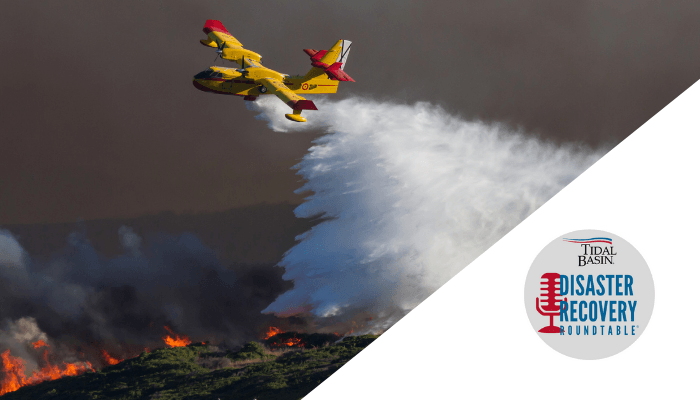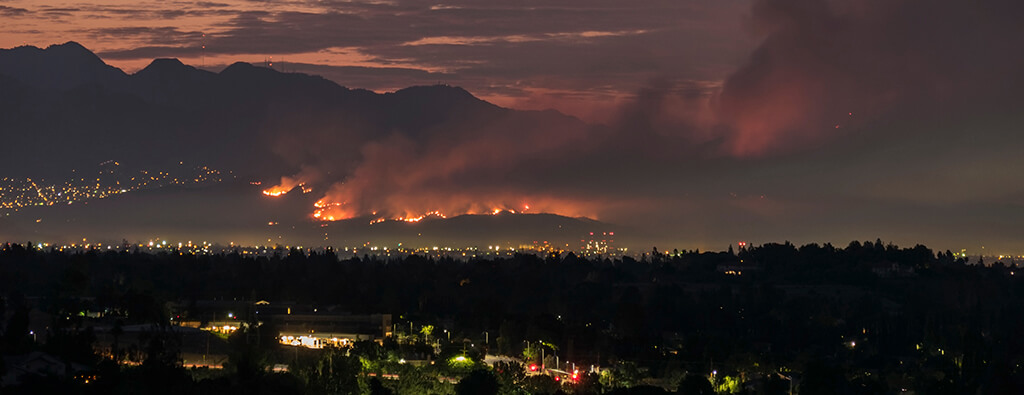California continues recovery efforts from a historic wildfire season which included some of the largest fires (in acreage burned) in state history. In Tidal Basin’s Top Ten Disasters of 2020 countdown, the California fires were second only to the COVID-19 pandemic for the worst disasters of the year. By the end of December 2020, over 9,000 fires burned nearly 4.4 million acres, or about 4% of the state’s approximate 100 million acres of land. The August Complex Fire has been classified as the first “gigafire”- burning over 1 million acres across seven counties. It was one of several large-scale fires and ranked as the Top 5 of the six largest fires in California’s recorded wildfire history. “It was a very historic year,” said Ryan Buras, Deputy Director with California Governor’s Office of Emergency Services (Cal OES). “Since August of last year, it’s pretty remarkable when you consider we’ve received 19 fire management assistance grants approved for 25 counties,” he said.
The year’s season was forecasted early in 2020 to be severe after an extremely dry January and February, which set the stage for a catastrophic season when extreme heat and high winds fueled hundreds of fires across the state in August and September. Typically, winter season precipitation balances the usually drier weather patterns in late summer and early fall. The precipitation also helps to replenish state reservoirs and build heavy snow packs which provide drinking water for millions of Californians when melting later in the spring.
“One thing we are doing here in California — we are really emphasizing — is the Interagency Recovery Coordination Team. So we are working with other state, local, and federal programs to work with the recovery support functions, so it’s truly a multi-agency response,” said Buras.
Due to the nature of ongoing events that California has faced over the last several years, the state continues to evolve around the phases of emergency from Recovery to Preparedness to Mitigation back to Response and Recovery again. “Our hazard mitigation teams have been providing assessments around the state to help locals mitigate against these fires and help locals prepare for these wildfires,” said Buras. Cal OES works closely with Cal Fire – the state’s forestry division that supports response to and recovery from wildfires.
The wildfires may be over, but now California is looking ahead to the next threats. The large burn scars could produce dangerous mud slides if heavy rains come through the rainy season. “We’ve been working closely with cities and counties throughout our Watershed Task Force to map out the possible threats and areas of risk where mudflows could be likely,” said Buras. “We lost a lot of property and land in areas that hadn’t burned in a long time, so we have been working to get those messages out and to inform the public.”
Unfortunately for California, 2020 was not a single occurrence. The state has suffered other large and destructive fire seasons in recent years. Prior to 2020, the2018 wildfire seasonwas the deadliest and most destructive wildfire season ever recorded inCalifornia, with more than 8,500 wildfires burning nearly 1.9 million acres. Insurance claims reached historic levels surpassing $12 billion.
From July to August 2018, a series of large wildfires erupted across California, mostly in the northern part of the state, including the Carr and Mendocino Complex Fires. In November 2018, strong winds aggravated conditions in another round of destructive fires. This new batch of wildfires included theWoolsey Fireand theCamp Fire, which killed at least 85 people and destroyed more than 18,000 structures, becoming both California’s deadliest and most destructive wildfire on record.
In January 2020, the California Department of Housing and Community Development (CA HCD) selected the Tidal Basin Group to support the development of the 2018 California Wildfires Community Development Block Grant-Disaster Recovery (CDBG-DR) Action Plan. The recovery and follow up CDBG programs continue for that disaster.
To learn more on preparing for wildfires and how the state responds to these events, visit the Cal Fire website.
Listen to our podcast about this topic:
View the full podcast page here.



